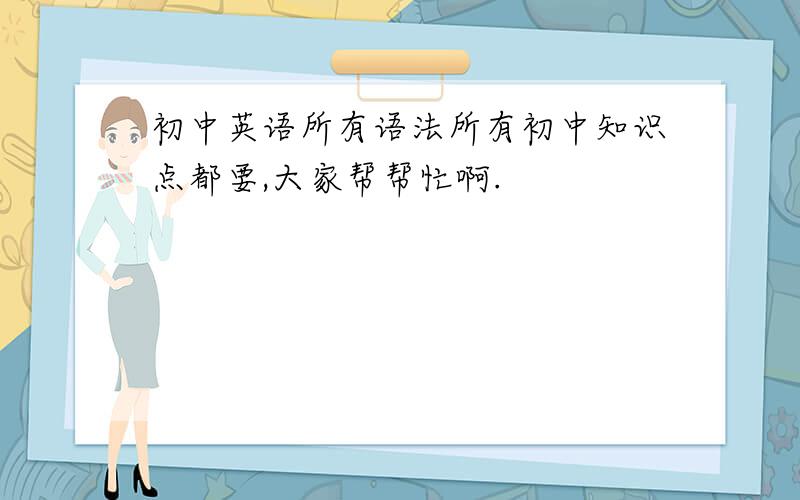初中英语所有语法所有初中知识点都要,大家帮帮忙啊.
来源:学生作业帮助网 编辑:作业帮 时间:2024/05/08 11:26:29

初中英语所有语法所有初中知识点都要,大家帮帮忙啊.
初中英语所有语法
所有初中知识点都要,大家帮帮忙啊.
初中英语所有语法所有初中知识点都要,大家帮帮忙啊.
英语的时态(tense)是一种动词形式,不同的时态用以表示不同的时间与方式.
下面就英语中常见的八种基本时态进行阐述,其它的时态都是在这八种时态的基础上结合而成的.
一、 一般现在时:
1.概念:经常、反复发生的动作或行为及现在的某种状况.
2.时间状语: always, usually, often, sometimes, every week (day, year, month…), once a week, on Sundays,
3.基本结构:动词 原形 (如主语为第三人称单数,动词上要加(e)S)
4.否定形式:am/is/are+not;此时态的谓语动词若为行为动词,则在其前加don't,如主语为第三人称单数,则用doesn't,同时还原行为动词.
5.一般疑问句:把be动词放于句首;用助动词do提问,如主语为第三人称单数,则用does,同时,还原行为动词.
6.例句:. It seldom snows here.
He is always ready to help others.
Action speaks louder than words.
二、 一般过去时:
1.概念:过去某个时间里发生的动作或状态;过去习惯性、经常性的动作、行为.
2.时间状语:ago, yesterday, the day before yesterday, last week(year, night, month…), in 1989, just now, at the age of 5, one day, long long ago, once upon a time, etc.
3.基本结构:be动词;行为动词
4.否定形式:was/were+not;在行为动词前加didn't,同时还原行为动词.
5.一般疑问句:was或were放于句首;用助动词do的过去式did 提问,同时还原行为动词.
6.例句:She often came to help us in those days.
I didn't know you were so busy.
三、 现在进行时:
1.概念:表示现阶段或说话时正在进行的动作及行为.
2.时间状语:now, at this time, these days, etc.
3.基本结构:am/is/are+doing
4.否定形式:am/is/are+not+doing.
5.一般疑问句:把be动词放于句首.
6.例句: How are you feeling today?
He is doing well in his lessons.
四、 过去进行时:
1.概念:表示过去某段时间或某一时刻正在发生或进行的行为或动作.
2.时间状语:at this time yesterday, at that time或以when引导的谓语动词是一般过去时的时间状语等.
3.基本结构:was/were+doing
4.否定形式:was/were + not + doing.
5.一般疑问句:把was或were放于句首.
6.例句:At that time she was working in a PLA unit.
When he came in, I was reading a newspaper.
五、 现在完成时:
1.概念:过去发生或已经完成的动作对现在造成的影响或结果,或从过去已经开始,持续到现在的动作或状态.
2.时间状语:recently, lately, since…for…,in the past few years, etc.
3.基本结构:have/has + done
4.否定形式:have/has + not +d one.
5.一般疑问句:have或has.
6.例句:I've written an article.
It has been raining these days.
六、 过去完成时:
1.概念:以过去某个时间为标准,在此以前发生的动作或行为,或在过去某动作之前完成的行为,即“过去的过去”.
2.时间状语:before, by the end of last year(term, month…),etc.
3.基本结构:had + done.
4.否定形式:had + not + done.
5.一般疑问句:had放于句首.
6.例句:As soon as we got to the station, the train had left.
By the end of last month. We had reviewed four books
七、 一般将来时:
1.概念:表示将要发生的动作或存在的状态及打算、计划或准备做某事.
2.时间状语:tomorrow, next day(week, month, year…),soon, in a few minutes, by…,the day after tomorrow, etc.
3.基本结构:am/is/are/going to + do;will/shall + do.
4.否定形式:was/were + not; 在行为动词前加didn't,同时还原行为动词.
5.一般疑问句:be放于句首;will/shall提到句首.
6.例句:They are going to have a competition with us in studies.
It is going to rain.
八、 过去将来时:
1.概念:立足于过去某一时刻,从过去看将来,常用于宾语从句中.
2.时间状语:the next day(morning, year…),the following month(week…),etc.
3.基本结构:was/were/going to + do;would/should + do.
4.否定形式:was/were/not + going to + do;would/should + not + do.
5.一般疑问句:was或were放于句首;would/should 提到句首.
6.例句:He said he would go to Beijing the next day.
I asked who was going there
还有个网站你自己可以看看http://zhidao.baidu.com/question/27835897.html
初中英语语法归纳知识点
1.主语:
差不多所有的词语都可以做主语,主语一般在句子的开端。
(特别)形式主语:
例句分析:To teach him is my job=It's my job to teach him.
这样主语就是to teach him,it为形式主语,代替to teach him.
2.谓语:
规则:1.助动词和动词一起构...
全部展开
初中英语语法归纳知识点
1.主语:
差不多所有的词语都可以做主语,主语一般在句子的开端。
(特别)形式主语:
例句分析:To teach him is my job=It's my job to teach him.
这样主语就是to teach him,it为形式主语,代替to teach him.
2.谓语:
规则:1.助动词和动词一起构成谓语;
2.情态动词和动词一起构成谓语;
3.连系动词和表语一起构成谓语。
注意:(这里的动词都是实义动词,表语是跟在连系动词后面的词。)
常见的连系动词有:be动词,sound,taste,become,turn,grow,keep......
3.状语:
表示 目的,地点,方式,程度,时间等的词叫做这个句子中的状语。
例句:(In order) to teach him ,I must work hard.
这里不定式做句子的目的状语。
He did it very carefully.
carefully 作句子的程度状语。
4.句型注意事项:
1.如果句子中谓语是及物动词,后面就是宾语
2.如果句子中的谓语是不及物动词,后面的就是句子的状语。
收起